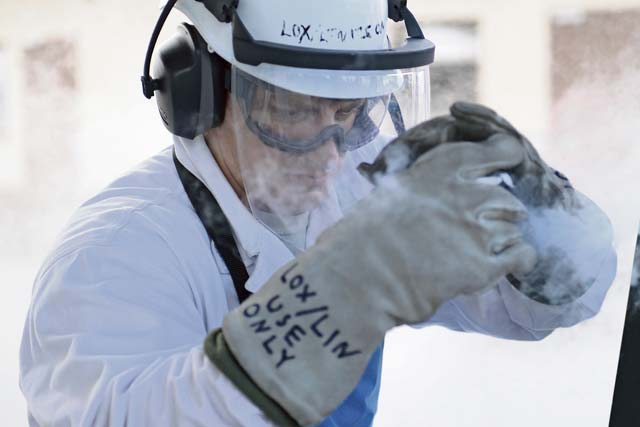
Breathing is one of the most basic, involuntary and often overlooked human actions. At higher altitudes, breathing can quickly become one of the most conscious thoughts as it becomes harder to do.
“A lot of people don’t even know about cryogenics … they don’t know what goes into getting (our product) out there,” said Senior Airman Jeffery Halda, 86th Logistics Readiness Squadron cryogenics technician.
The 86th Logistics Readiness Squadron cryogenics team helps ensure aircrew members can breathe easily at altitudes higher than 10,000 feet. On Ramstein, a cryogenics job is to receive, store, maintain and issue liquid oxygen and liquid nitrogen for aircrew members.
“My job is to keep planes flying,” Halda said. “Without us, the mission wouldn’t continue, because the aircrew members couldn’t breathe.”
Liquid oxygen can burn right through skin, because it is minus 297 degrees Fahrenheit, and liquid nitrogen is minus 321 degrees Fahrenheit. To ensure their safety, the cryogenics team ensures they wear their full body coats, aprons, gloves, face masks, goggles and ear protection.
“If you talk to most people who work on the flightline, they will tell you a common misconception about the amount of work that we do,” Halda said.
The cryogenics team fills tanks full of liquid oxygen and liquid nitrogen and then transports them onto the flightline to ensure the pilots have enough to accomplish their mission.
Senior Airman Seth Bruning, 86th Logistics Readiness Squadron hydrants technician, said that in an average month, they fill about 5,000 gallons of liquid oxygen and 8,000 gallons of liquid nitrogen.
After filling the tanks, the cryo-technicians sample the chemicals inside of them then send them off to a lab for a more intensive examination. The liquid oxygen is then stored as a gas since it is eight times more condensed than the liquid form.
“We take a sample, let the pressure build up to about 15 to 19 pounds per square inch and turn it into gas,” Bruning said. “Once it’s in a gas state, we ship it to one of our aerial labs, and they run tests on the samples.”
The Air Force standard for liquid oxygen is 99.5 percent purity; however, the cryogenics team consistently maintains a higher level.
Cryogenics guarantees aircrew members will have fresh, clean oxygen as they complete their mission. Without cryogenics, any flying mission would be nearly impossible.


